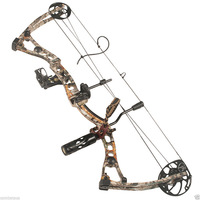Posted by Heidi Cridland on 2nd Dec 2015
Compound Bow History

A compound bow is a type of bow that makes use of pulleys and cables as a leveraging system to bend its limbs. It is the more modern type of bow used today.
With the pulley system on the bow, you have an advantage mechanically. As such, a compound bow’s limbs are usually much stiffer than the limbs of longbows or recurve bows. Because of this stiffness, compound bows tend to be more efficient in terms of energy than other types of bows. This because there is less energy being used in the movement of limbs. Compound bows are constructed with higher technology than most other bows. As a result of this and the intense stiffness, the compound bow is more accurate than others as its sensitivity to temperature fluctuations and humidity is reduced.
The pulley or cam system of the compound bow presents an advantage known as a let off. When the string is pulled back, the pulleys swivel. The pulleys are unconventional, not circular; hence their effectual radius varies as they swivel. When the bow reaches full draw, the alteration in the radius of the pulley has more or less doubled your mechanical advantage. This results in less force being required to hold the compound bow at full draw. The let off gives the compound bow a distinguishing draw-force curve. This is a rapid ascent to its optimal force and then deteriorating to a lesser holding force. The precise nature of the curve is a utility of the geometry of the pulley, and this depends on your preference when you purchase a compound bow.
Compound Bow History
The first ever compound bow (on record, at least) was created by Holless Wilbur Allen in 1966 in Billing, Missouri. Three years later, a US patent was granted for the bow. Since then, the compound bow has increased in popularity all across the United States and other parts of the world. Today, it is the most widely used variety of bow.
The types of arrows that are used with compound bows are not too different from the types of arrows that are used with recurve bows. These arrows are usually made from carbon fibre or from an aluminium allow or from a combination of both of these. Compound bow arrow spines, though, are not as great as they are for recurve bows of the same power (draw weight). The spine is usually used to determine the stiffness of the arrow. The reason for the difference in the spine of the arrows is that the compound bow accelerates an arrow a lot more gently and in a more linear fashion as the pulley loosens, and hence flexes the arrows a lot less. This is as it would be when compared to an explosive acceleration that would emanate from a recurve bow. In a recurve bow, the limbs’ full power is applied to the arrow when it is released from the string.
The Atunga compound bow is an example of a high quality, effective compound bow used widely by archers in Australia. It may look complicated at first with the pulleys and stabilizers and everything else. However, once you grow accustomed to it, it’s easy as pie.

